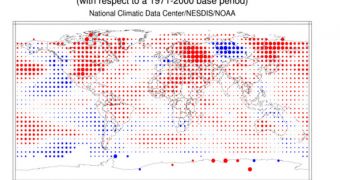According to official statistics provided by the US National Oceanic and Atmospheric Administration (NOAA) National Climatic Data Center (NCDC), it would appear that this year's July was the seventh warmest on record.
This record spans back all the way to 1880. It was then that meteorologists began keeping accurate and detailed archives of temperatures at thousands of points across the planet's surface. Back in 1979, the launch of weather satellites also enabled experts to monitor sea ice extent.
NCDC data reveal that sea ice extent for July 2011 was the lowest since satellite surveillance began. The new study is part of a set of climate analysis that the Center is providing for the US Government and the international scientific community.
The new charts indicates that sea ice extent was no less than 21.6 percent below average last month, which is a massive difference. The previous record low was established in 2007. The new one was no less than 81,000 square miles (210,000 square kilometers) below the previous July record low.
“The combined global land and ocean average surface temperature for July 2011 was the seventh warmest on record for that month at 61.43 F (16.37 C), which is 1.03°F (0.57°C) above the 20th century average of 60.4°F (15.8°C),” the NCDC report explains.
The 20th century average global land surface temperature was established at 57.8 degrees Fahrenheit (14.3°Celsius). For this July, mean temperatures were established to be 1.51 degrees Fahrenheit (0.84°Celsius) higher. This is a substantial difference.
“Warmer-than-average conditions occurred across Northern Europe, western and eastern Russia, and most of North America. Cooler-than-average regions included central Russia, Western Europe, much of the western United States, and southwestern Canada,” the report explains.
Interestingly, the statistics show that neither El Niño, nor La Niña conditions were present during July 2011. These two ocean-atmosphere-coupled phenomena usually have the ability to influence weather patterns around the world, and they are usually the ones that make a difference.
“The combined global land and ocean average surface temperature for the January – July period was 0.92°F (0.5°C) above the 20th century average of 56.9°F (13.8°C), making it the 11th warmest such period on record. The margin of error is +/- 0.16°F (0.09°C), the report concludes.
NOAA is providing round-the-year cover of major global temperature highlights, through services such as the NCDC and the National Snow and Ice Data Center (NSIDC).

 14 DAY TRIAL //
14 DAY TRIAL //